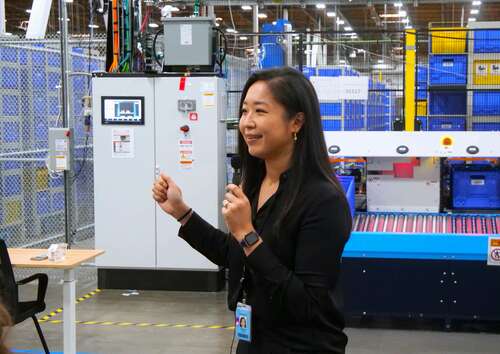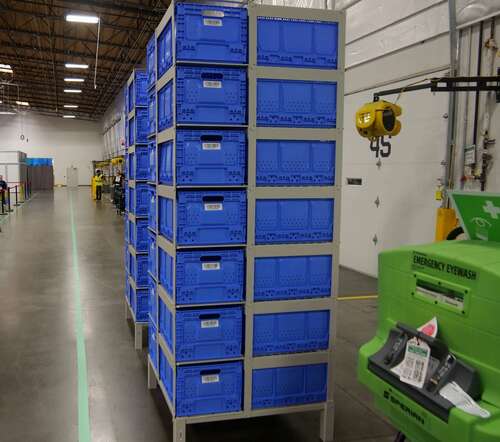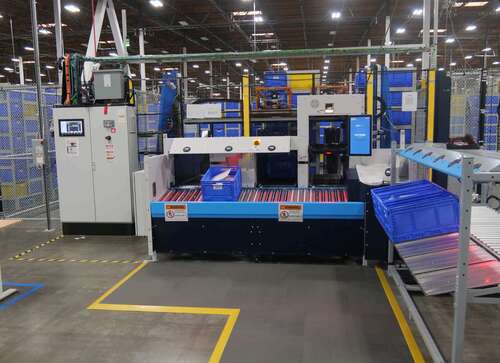
SUMNER, Wash. — Can robots make warehouses both faster and safer?
That’s the Holy Grail of modern logistics, and it’s the promise Amazon is making with “Sequoia,” unveiled last week as part of a day-long media event at the company’s robotics testing ground south of Seattle.
The new robotic system, developed in secret up to this point, has now been rolled out for testing at an Amazon warehouse in Houston. The move comes as Amazon faces growing scrutiny over the safety of its warehouse operations and continues to push to achieve faster delivery times.
We got a first-hand look and a guided tour of the new robotic system with Rain Wang, an Amazon senior technical product manager who leads the Sequoia project, during a tour at Amazon’s “Delivering the Future” event in Sumner. Later, we sat down to discuss the details with Scott Dresser, Amazon Robotics vice president.
“When you think about a fulfillment center in the Amazon network, it’s our vision for what storage is going to look like going forward,” Dresser said.
Watch a video below and continue reading for details.
The basics: Sequoia is a containerized storage system that presents totes to employees in their ergonomic power zones, between mid-thigh and mid-chest, at an angle that makes it easier for them to reach inside to grab items.
It’s an alternative to the tall fabric pods that require employees to reach above their heads or stoop down.
The totes are delivered from storage structures, transported by autonomous mobile robotic platforms, and inserted into an employee workstation using a gantry system (the blue structure behind the cage in the video above). The totes move through the system without employees needing to lift or push them along the way.

Speed data: Sequoia is able to identify and store inventory up to 75% faster than Amazon’s current system can, which allows the company to list items faster, Wang said during the demo. That enables orders to be fulfilled up to 25% faster, along with the ability to estimate delivery times more accurately.
This means customers will be able to order products later in the day and still receive same-day or next-day delivery.
Safety numbers: Overall, Amazon says recordable incident rates were 15% lower at Amazon Robotics sites than they were at its non-robotics sites in 2022, and Wang said Sequoia “will meaningfully continue that trend.”
However, Amazon isn’t yet disclosing specific data about Sequoia’s impact on injury rates, Dresser said in an interview.

“We’ve done some ergonomic studies, and we have some ideas about where we’re going, but we’re not ready to share that yet,” he said, explaining that data from the Houston rollout will provide more internal evidence to evaluate.
Sequoia and Sparrow: Sequoia works in conjunction with Sparrow, the first Amazon robotic arm that can pick up individual items of different shapes and sizes, a tougher challenge than picking up boxes and envelopes.
We got our first glimpse of Sparrow during a visit to Amazon’s fulfilment center in San Marcos, Texas, this summer. The robotic arm is now being used in Houston to consolidate products from multiple totes into a single tote.
That consolidation by Sparrow will play a key role in making the Sequoia system more efficient, ensuring that products are packed into as few totes as possible, minimizing the total space required in the warehouse.
“We look at Sparrow as a component of the overall Sequoia system,” Dresser said.
The noise: Listening to the video of Sequoia above, you’ll hear a lot of noise. Responding to a reporter’s question, Wang acknowledged the issue and said the company is actively working to reduce the noise by implementing higher quality belts in the gantry system with lower levels of vibration.

What about the name? A number of Amazon’s previous warehouse robots have used bird names, including Sparrow, Cardinal, and Robin (which is short for robotic induction). So we wondered, with the introduction of Sequoia, will all future robots be named after trees?
Actually, that’s not quite how it works, Dresser explained. The names differ depending on the type of robot and the team that develops it. Sequoia is made by the containerized storage robotics team, which uses trees for names.
For example, one early prototype was called “Redwood,” Dresser said.
Long story short, Amazon isn’t done releasing robots named after birds.
“We have lots of birds,” Dresser said with a laugh. “More birds coming.”

